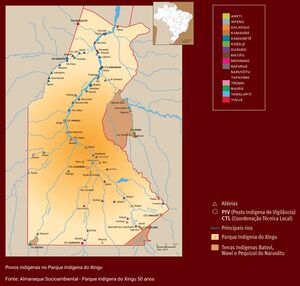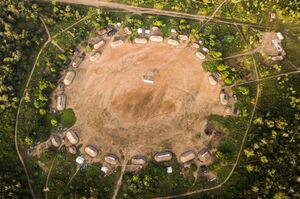Upper Xingu: Difference between revisions
No edit summary |
Aguerreiro (talk | contribs) mNo edit summary |
||
| Line 1: | Line 1: | ||
[[File:Map of the Upper Xingu.jpg|thumb|Map of the Upper Xingu. Source: Instituto Socioambiental]]The Upper Xingu is one of the research areas related to the Ekologos project, where Prof. Antonio Guerreiro carries out research on the transformation of fishing technologies among the Kalapalo people.<ref>{{Cite journal |last=Andrello |first=Geraldo |last2=Guerreiro |first2=Antonio |last3=Hugh-Jones |first3=Stephen |date=2015 |title=Space-time transformations in the upper Xingu and upper Rio Negro |journal=Sociologia & Antropologia |volume=5 |pages=699-724}}</ref> | [[File:Map of the Upper Xingu.jpg|thumb|Map of the Upper Xingu. Source: Instituto Socioambiental]]The Upper Xingu is one of the research areas related to the Ekologos project, where Prof. Antonio Guerreiro carries out research on the transformation of traditional fishing technologies among the Kalapalo people.<ref>{{Cite journal |last=Andrello |first=Geraldo |last2=Guerreiro |first2=Antonio |last3=Hugh-Jones |first3=Stephen |date=2015 |title=Space-time transformations in the upper Xingu and upper Rio Negro |journal=Sociologia & Antropologia |volume=5 |pages=699-724}}</ref> | ||
The Upper Xingu is located at the Xingu Indigenous Territory, in Brazil. It is a multiethnic and multilingual complex, inhabited by 11 peoples speaking languages from three of the most important linguistic groups of Lowland South America and an isolate. It is located in a transition zone between the Brazilian Savannah, on the south, and the Amazonian rainforest, which extends to the north. | The Upper Xingu is located at the Xingu Indigenous Territory, in Brazil. It is a multiethnic and multilingual complex, inhabited by 11 peoples speaking languages from three of the most important linguistic groups of Lowland South America (Arawak, Carib and Tupi) and an isolate (Trumai). It is located in a transition zone between the Brazilian Savannah, on the south, and the Amazonian rainforest, which extends to the north. | ||
Our project is being carried out with the Kalapalo, one of the Carib-speaking peoples of the area, who have a population around 1000 persons living in 13 villages, most of them near the Culuene river and its tributaries. Our Kalapalo partners live at the Aiha village, on the eastern area of the Culuene, and where 238 people currently live. | Our project is being carried out with the Kalapalo, one of the Carib-speaking peoples of the area, who have a population around 1000 persons living in 13 villages, most of them near the Culuene river and its tributaries. Our Kalapalo closest partners live at the Aiha village, on the eastern area of the Culuene, and where 238 people currently live. | ||
== Research questions == | == Research questions == | ||
| Line 9: | Line 9: | ||
== Research publications == | == Research publications == | ||
{{reflist}}[[File:Aiha village aerial photo.jpg|thumb|Kalapalo | {{reflist}}[[File:Aiha village aerial photo.jpg|thumb|Aerial view of Aiha, the main Kalapalo village. Credits: Thomaz Pedro]] | ||
[[Category:Research locations]] | [[Category:Research locations]] | ||
Revision as of 15:07, 21 June 2024
The Upper Xingu is one of the research areas related to the Ekologos project, where Prof. Antonio Guerreiro carries out research on the transformation of traditional fishing technologies among the Kalapalo people.[1]
The Upper Xingu is located at the Xingu Indigenous Territory, in Brazil. It is a multiethnic and multilingual complex, inhabited by 11 peoples speaking languages from three of the most important linguistic groups of Lowland South America (Arawak, Carib and Tupi) and an isolate (Trumai). It is located in a transition zone between the Brazilian Savannah, on the south, and the Amazonian rainforest, which extends to the north.
Our project is being carried out with the Kalapalo, one of the Carib-speaking peoples of the area, who have a population around 1000 persons living in 13 villages, most of them near the Culuene river and its tributaries. Our Kalapalo closest partners live at the Aiha village, on the eastern area of the Culuene, and where 238 people currently live.
Research questions
Methodologies used
Research publications
- ^ Andrello, Geraldo; Guerreiro, Antonio; Hugh-Jones, Stephen (2015). "Space-time transformations in the upper Xingu and upper Rio Negro". Sociologia & Antropologia. 5: 699–724.

